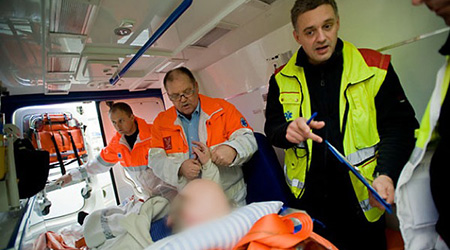
Studies like DANAMI-2 (Andersen, HR et. al. 2003) have proved that Primary Percutaneous Coronary Intervention (PPCI) is superior to fibrinolysis in patients with ST-Elevation Myocardial Infarction (STEMI). Therefore, PPCI has been implemented as the routine reperfusion strategy in Denmark. Based on the Western Denmark Heart Registry (WDHD) a number of studies have been performed assessing the association between delay to reperfusion and outcome. Lately, the research group has documented that a delay from the first medical contact to reperfusion (health care system delay) is associated with not only increased risk of mortality (Therkelsen, CJ. et al. 2010) but also the risk of readmission due to heart failure (Therkelsen, CJ. et al. 2011). Pre-hospital diagnosis with field-triage of patients with STEMI directly to the cathetherisation laboratory is now considered mandatory to reduce system delay and ensure optimal outcome. Despitetechnological advances , it is still difficult to identify patients with acute myocardial infarction (AMI) without an ECG showing ST-elevation or Bundle Branch Block (BBB). The study on pre-hospital obtained biomarkers (PREHAP) is a great example of our work on defining new ways to assist the diagnostic process. The initial study found that a qualitative Troponin test could be implemented successfully and indicated that biomarkers could contribute significantly to pre-hospital diagnosis of AMI. A recently launched randomized study (NONSTEMI) investigates whether patients with Non-ST-Segment-Elevation Myocardial Infarction (NONSTEMI) will benefit from PPCI instead of conventional medical therapy and angiography within 72 hours. In this study pre-hospital biomarker analysis is crucial.
Another key research area is out-of-hospital cardiac arrests. Quality of heart-lung-resuscitation (HLR) is a key determinant of outcome in patients with out-of-hospital cardiac arrest. An initial feasibility study has documented that especially when the patient is transported to the ambulance there is a substantial (3-4 minutes) break in HLR simply because HLR is impossible to perform during loading of the patient by the two ambulance staff. An ongoing PhD-study evaluates the quality of HLR and describes the in-hospital use of cooling therapy and acute angiography. Furthermore, an ongoing study evaluates the value of mechanical chest compression devices in the pre-hospital phase.
The overall purpose of pre-hospital research is to perform studies that can improve diagnosis, triage, therapy and outcome in patients with acute myocardial infarction (AMI) and patients with out-of-hospital cardiac arrest.
Contacts
Hans Erik Bøtker, Professor, MD, DMSci, heb@dadlnet.dk
Christian Juhl Terkelsen, Associate Professor, MD, PhD, christian_juhl_terkelsen@hotmail.com
Jens Flensted Lassen, Associate Professor, MD, PhD, jens.lassen@ki.au.dk
Jacob Thorsted Sørensen, MD, PhD, jacobthorsted@gmail.com
Carsten Steengaard, MD, carsten.stengaard@ki.au.dk
Other contact persons and senior research members that can provide you with information about research performed in this research group:
Henning Rud Andersen, Professor, MD, DMSci, henning.rud.andersen@dadlnet.dk
Kristian Thygesen, Professor, MD, DMSci, kristhyg@rm.dk
Mads Peter Andersen, MD, PhD, madspeterandersen@gmail.com
Niels Henrik Krarup, MD, nhkrarup@gmail.com
Tinne Tranberg, MD, tinne_tranberg@hotmail.com
Morten Bøtker, MD, morten.boetker@aarhus.rm.dk
Martin Rasmussen, MD, rasmu05@gmail.com